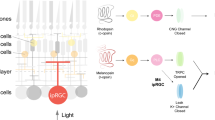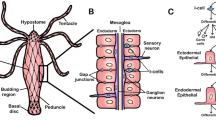Summary
The ultrastructure of the pars intermedia of Rana catesbeiana tadpoles was studied following isolation from the hypothalamus, in vivo after sectioning of the pituitary stalk, and in vitro after implantation of the pituitary into a piece of tail fin. Both experimental procedures were followed by rapid and sustained skin darkening. Pituitaries from normal light and dark adapted tadpoles served as controls.
In 4-hour disinhibited glands, melanotrophs revealed hyperactive Golgi bodies, colloid vesicles (1–2 microns) in close proximity to axon terminals, and no apparent loss of secretory granules. At 24 hours extracellular colloid adjacent to axon terminals was found, and extensive arrays of RER appeared in the melanotrophs. Obvious granule loss from secretory cells occurred within a week, by which time the cytoplasm was occupied by large cisterns of SER and RER and abundant free ribosomes. Dense core vesicles (600–900 Å) in aminergic nerve terminals disappeared shortly after isolation of the pituitary from the hypothalamus, and only decreasing numbers of translucent vesicles (200–300 Å) were found.
The functional significance of these changes is discussed, with particular emphasis on the mode of acute hormone release.
Similar content being viewed by others
References
Celis, M. E., Taleisnik, S., Schwartz, I. L., Walter, R.: Regulation of formation and proposed structure of the factor inhibiting the release of melanocyte-stimulating hormone. Proc. nat. Acad. Sci. (Wash.) 68, 1428–1433 (1971).
Dawson, A. B.: Evidence for termination of neurosecretory fibers within the pars intermedia of the hypophysis of the frog. Anat. Rec. 115, 62–70 (1953).
Dawson, C. D., Ralph, C. L.: Neural control of the amphibian pars intermedia: electrical responses evoked by illuminated of the lateral eyes. Gen. comp. Endocr. 17, 611–614 (1971).
Derby, A.: An in vitro quantitative analysis of the response of tadpole tissue to thyroxine. J. exp. Zool. 168, 147–156 (1968).
Doerr-Schott, J., Follenius, E.: Innervation de l'hypophyse intermédiaire de Rana esculenta, et identification des fibres aminergiques par autoradiographie au microscope électronique. Z. Zellforsch. 106, 99–118 (1970).
Enemar, A., Falck, B.: On the presence of adrenergic nerves in the pars intermedia of the frog Rana temporaria. Gen. comp. Endocr. 5, 577–583 (1965).
Enemar, A., Falck, B., Iturriza, F. C.: Adrenergic nerves in the pars intermedia of the pituitary in the toad, Buffo arenarum. Z. Zellforsch. 77, 325–330 (1967).
Etkin, W.: On the control of growth and activity of the pars intermedia of the pituitary by the hypothalamus in the tadpole. J. exp. Zool. 86, 113–139 (1941).
Etkin, W.: Hypothalamic inhibition of the pars intermedia activity in the frog. Gen. comp. Endocr., Suppl. 1, 148–159 (1962a).
Etkin, W.: Neurosecretory control of the pars intermedia. Gen. comp. Endocr. 2, 161–169 (1962b).
Etkin, W.: Relation of the pars intermedia to the hypothalamus. In: Neuroendocrinology. (L. Martini and W. Ganong, eds.), vol. II, p. 261–282. New York: Acad. Press 1967.
Etkin, W.: Rosenberg, L.: Infundibular lesion and pars intermedia activity in the tadpole. Proc. Soc. exp. Biol. (N.Y.) 39, 322–334 (1938).
Gopal Dutt, N. H., Rajasekharasetty, M. R.: Effect of nembutal and nialimide on the pars intermedia and skin colour changes in Rana cyanophlyctis Schneider. Acta endocr. (Kbh.) 68, 264–270 (1971).
Hogben, L., Slome, D.: The pigmentary effector system VIII: The dual receptive mechanism of the amphibian background response. Proc. roy. Soc. B 120, 158–173 (1936).
Hopkins, C. R.: Studies on secretory activity of the pars intermedia of Xenopus laevis: 1. Fine structural changes related to the onset of secretory activity in vivo. Tissue and Cell 2, 59–77 (1970a).
Hopkins, C. R.: 2. A biochemical and electron cytochemical investigation of acid hydrolase activity following the stimulation of secretory activity in vivo. Tissue and Cell. 2, 78–81 (1970b).
Hopkins, C. R.: 3. The synthesis and release of melanocyte stimulating hormone (MSH) in vitro. Tissue and Cell. 2, 82–98 (1970c).
Hopkins C. R.: Studies on innervation of the pars intermedia in Xenopus laevis. Mem. Soc. Endocrinol. 19, 823–825 (1971a).
Hopkins, C. R.: Localization of adrenergic fibres in the amphibian pars intermedia by electron microscopic autoradiography and their selective removal by 6-hydroxydopamine. Gen. comp. Endocr. 16, 112–120 (1971b).
Howe, A., Maxwell, D. S.: Electron microscopy of the pars intermedia of the pituitary gland in the rat. Gen. comp. Endocr. 11, 169–185 (1968).
Imai, K.: Light and electron microscopy studies on the pars intermedia of the pituitary of Xenopus laevis under different experimental conditions. Gunma Symp. Endocrinol. 6, 89–105 (1969).
Ito, T.: Experimental studies on the hypothalamic control of the pars intermedia activity of the frog, Rana nigromaculata. Neuroendocrinology 3, 25–33 (1968).
Ito, T.: Further studies on the hypothalamic control of the pars intermedia activity of the frog, Rana nigromaculata. Gunma Symp. Endocrinol. 6, 79–88 (1969).
Ito, T.: Changes in skin color and fine structure of the intermediate pituitary gland of the frog, Rana nigromaculata, after extirpation of the median eminence. Neuroendocrinology 8, 180–197 (1971).
Iturriza, F. C.: Monoamines and control of the pars intermedia of the toad pituitary. Gen. comp. Endocr. 6, 19–25 (1966).
Iturriza, F. C.: The secretion of intermedian in autotransplants of pars intermedia growing in the anterior chamber of intact and sympathectomized eyes of the toad. Neuroendocrinology 2, 11–18 (1967).
Iturriza, F. C: Further evidence for blocking of catecholamines on the secretion of melanocyte stimulating hormone in toads. Gen. comp. Endocr. 12, 417–426 (1969).
Iturriza, F. C., Koch, O. R.: Histochemical localization of some alpha MSH amino acid constituents in the pars intermedia of the toad pituitary. J. Histochem. Cytochem. 12, 45–46 (1964a).
Iturriza, F. C.: Effect of administration of lysergic acid (LSD) on the colloid vesicles of the pars intermedia of the toad pituitary. Endocrinology 75, 615–616 (1964b).
Jørgensen, C. B., Larsen, L. O.: Nature of the nervous control of pars intermedia function in amphibians: rate of functional recovery after denervation. Gen. comp. Endocr. 3, 468–472 (1963).
Kappers, A. J.: Innervation of the pineal organ: Phylogenetic aspects and comparison of the neural control of the mammalian pineal with that of other neuroendocrine systems. Mem. Soc. Endocrinol. 19, 27–48 (1971).
Kastin, A. J., Schally, A. V., Viosca, S.: Inhibition of MSH release in frogs by direct application of L-prolyl-L-leucyl-glycinamide to the pituitary. Proc. Soc. exp. Biol. (N.Y.) 137, 1437–1439 (1971).
Lever, J. D., Jeacock, M. K., Young, G. G.: The production and cure of metahypophyseal diabetes in the cat: a biochemical and electron microscopical study with particular reference to changes in the islets of Langerhans of the pancreas. Proc. roy. Soc. B 154, 139–150 (1961).
Masur, S.: Fine structure of the autotransplanted pituitary in the red eft, Notophthalmus viridescens. Gen. comp. Endocr. 12, 12–32 (1969).
Nair, R. M. G., Kastin, A. J., Schally, A. V.: Isolation and structure of hypothalamic MSH release-inhibiting hormone. Biochem. biophys. Res. Commun. 43, 1367–1381 (1971).
Nakai, Y., Gorbman, A.: Evidence for a doubly innervated secretory unit in the anuran pars intermedia. II. Electron microscopic studies. Gen. comp. Endocr. 13, 108–116 (1969).
Oshima, K., Gorbman, A.: Evidence for a doubley innervated secretory unit in the anuran pars intermedia. I. Electrophysiologic studies. Gen. comp. Endocr. 13, 98–107 (1969).
Pehlemann, F. W.: Ultrastructure and innervation of the pars intermedia of the pituitary of Xenopus laevis. Gen. comp. Endocr. 9, 481 abst. (1967).
Ralph, C. L., Sampath, S.: Inhibition by extracts of frog and rat brain of MSH release by frog pars intermedia. Gen. comp. Endocr. 7, 370–374 (1966).
Rodríguez, E. M.: The nervous control of the pars intermedia of an amphibian and reptilian species. Mem. Soc. Endocrinol. 19, 827–837 (1971).
Sachs, H., Share, L., Osinchak, J., Carpi, A.: Capacity of the neurohypophysis to release vasopressin. Endocrinology 81, 755–770 (1967).
Saland, L. C.: Ultrastructure of the frog pars intermedia in relation to hypothalamic control of hormone release. Neuroendocrinology 3, 72–88 (1968).
Threadgold, L. T.: The ultrastructure of the animal cell. The ultrastructure of the cytosome. II (p. 131). New York: Pergamon Press 1967.
Weatherhead, B., Thornton, V. F., Whur, P.: Effects of change of background colour on the ultrastructure of the MSH cells of the pars intermedia of Xenopus laevis: a quantitative description. J. Endocr. 49, XXV-XXVI (1971).
Vincent, D. S., Anand Kumar, T. C.: Electron microscopic studies of the pars intermedia of the ferret. Z. Zellforsch. 99, 185–197 (1969).
Author information
Authors and Affiliations
Additional information
This study was carried out in the Department of Anatomy, Albert Einstein College of Medicine, New York. I am greatly indebted to Professor Berta Scharrer and Professor William Etkin for their sponsorship, guidance and encouragement. Warm thanks are due to Mrs. Sarah Wurzelmann and Mr. Stanley Brown for their technical assistance. Support from U.S.P.H.S. grants NIH-NB 00840, NIH R01 Am 3984 and NSF Grant 12353 is gratefully acknowledged.
Rights and permissions
About this article
Cite this article
Castel, M. Ultrastructure of the anuran pars intermedia following severance of hypothalamic connection. Z.Zellforsch 131, 545–557 (1972). https://doi.org/10.1007/BF00306970
Received:
Issue Date:
DOI: https://doi.org/10.1007/BF00306970




